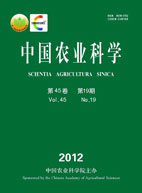-
Characteristics of Annual Water Utilization in Winter Wheat- Summer Maize Rotation System in North China Plain
- QIN Xin, LIU Ke, ZHOU Li-Li, ZHOU Shun-Li, LU Lai-Qing, WANG Run-Zheng
-
Scientia Agricultura Sinica. 2012, 45(19):
4014-4024.
doi:10.3864/j.issn.0578-1752.2012.19.013
-
 Abstract
(
827 )
Abstract
(
827 )
 PDF (363KB)
(
816
)
PDF (363KB)
(
816
)
 Save
Save
-
References |
Related Articles |
Metrics
【Objective】The objective of this experiment is to quantitatively study the characteristics of annual water utilization in winter wheat-summer maize rotation system in North China Plain.【Method】The experiment with four water treatments applied in wheat growing season including no irrigation (W0), irrigation at jointing (W1), irrigation at both jointing and anthesis (W2), and irrigation at regreening, booting, anthesis and grain filling (W4) was conducted for two continuous rotation cycles in 2008-2010 under field conditions.【Result】The highest yield of wheat and annual crops (wheat plus maize) were obtained in W1 and W2, respectively, and no significant differences were found in the yield of following maize. Water use efficiency (WUE) of wheat had a similar performance to its yield. The WUE of maize was significantly higher than that of wheat, and decreased significantly with the increase of irrigation amount. The highest annual WUE was obtained in W0 or W1, and then decreased significantly with the increase of irrigation amount. There was no significant difference in soil water storage of 2 m depth soil body in the treatment of W4 at different stages of wheat and maize. However, the soil water content reduced continuously following wheat growth in the other water treatments, and the less of irrigation amount, the bigger of decreasing range of soil water content, and it reached the lowest point at wheat harvest stage. At maize jointing stage, there was no difference in soil water content among all of the water treatments because of precipitation, and correspondingly, 178-188 mm (W0), 124-160 mm (W1), 38-93 mm (W2), and -30-21 mm (W4) rainfall were stored in 2 m depth soil body, respectively. Crop water consumption intensity and seasonal evapotranspiration (SET) increased as irrigation amount increased. There were no differences in the characteristics of water consumption and soil water content among all of water treatments after maize jointing stage. Drainage occurred because of precipitation, 163 mm (W0, W1), 181 mm (W2), and 217 mm (W4) in wet year and 13 mm (W0, W1, W2), and 45 mm (W4) in normal year were determined. There were 127 mm (W0) and 57 mm (W1) water entered groundwater in wet year.【Conclusion】Water-saving cultivation in wheat reduces the exploitation of groundwater obviously, and the use efficiency of rainfall is enhanced significantly, as a result, higher annual WUE and supplementary on groundwater by rainfall in wet year are implemented, so the practice of W1 in wet year and W2 in normal year is benefit to the combination of higher WUE and high-yielding, and it is very important to the sustainable development in agriculture in North China Plain.









